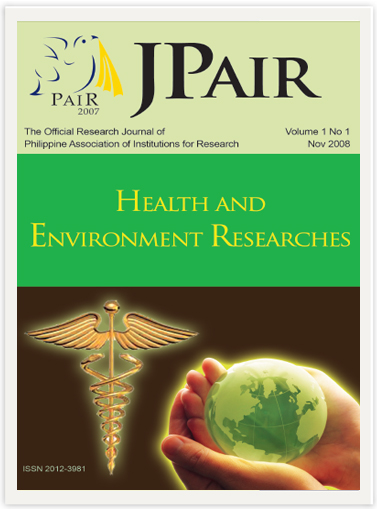Philippines 2007 Regional Study on Smoking in Girls and Young Women
DOI:
https://doi.org/10.7719/jpair.v1i1.39Keywords:
Smoking, Young WomenAbstract
The 2007 Philippines Regional Survey on Smoking in Girls and Young Women provides updated information on women and young girls' smoking experiences and behaviors, awareness of smoking bans and advertisements, attitudes and beliefs about smoking, and the smoking prevalence and behavior of their family members. A cross-sectional survey was conducted for Phase I and a qualitative study for Phase II, involving 3,000 respondents from 15 schools and 14 colleges in Manila and Zamboanga. Quantitative findings revealed a 37.8% prevalence of respondents who had ever smoked cigarettes, with 18.7% being current smokers, and 60.3% first trying smoking at age 18 or older. Qualitative results highlighted mixed tobacco promotions in the country, weak enforcement of penalty measures, and widespread cigarette access despite high awareness of anti-smoking messages. Tobacco advertisements continue to target young girls and women effectively. The study suggests promising counter-strategies, including stricter sanctions for violators of smoking policies, enhanced media campaigns on smoking's adverse effects, and health programs focused on intervention and education. Recommendations emphasize forging strong community-school partnerships, initiating teacher training programs, and implementing monitoring systems in schools to prevent smoking among young people. Additionally, there is a need for more empirical evidence on penalties for policy violations and pictorial health warnings on cigarette packs to curb smoking prevalence effectively
Downloads
References
Alechnowicz, K., & Chapman, S. (2004). The Philippines tobacco industry: “The strongest lobby in Asia.” Tobacco Control, 13(1), 71–78.
Downloads
Published
Issue
Section
License
Copyright (c) 2008 Chona Q. Sarmiento

This work is licensed under a Creative Commons Attribution-NonCommercial 4.0 International License.
Open Access. This article published by JPAIR Multidisciplinary Research is licensed under a Creative Commons Attribution-Noncommercial 4.0 International (CC BY-NC 4.0). You are free to share (copy and redistribute the material in any medium or format) and adapt (remix, transform, and build upon the material). Under the following terms, you must give appropriate credit, provide a link to the license, and indicate if changes were made. You may do so in any reasonable manner, but not in any way that suggests the licensor endorses you or your use. You may not use the material for commercial purposes.




















